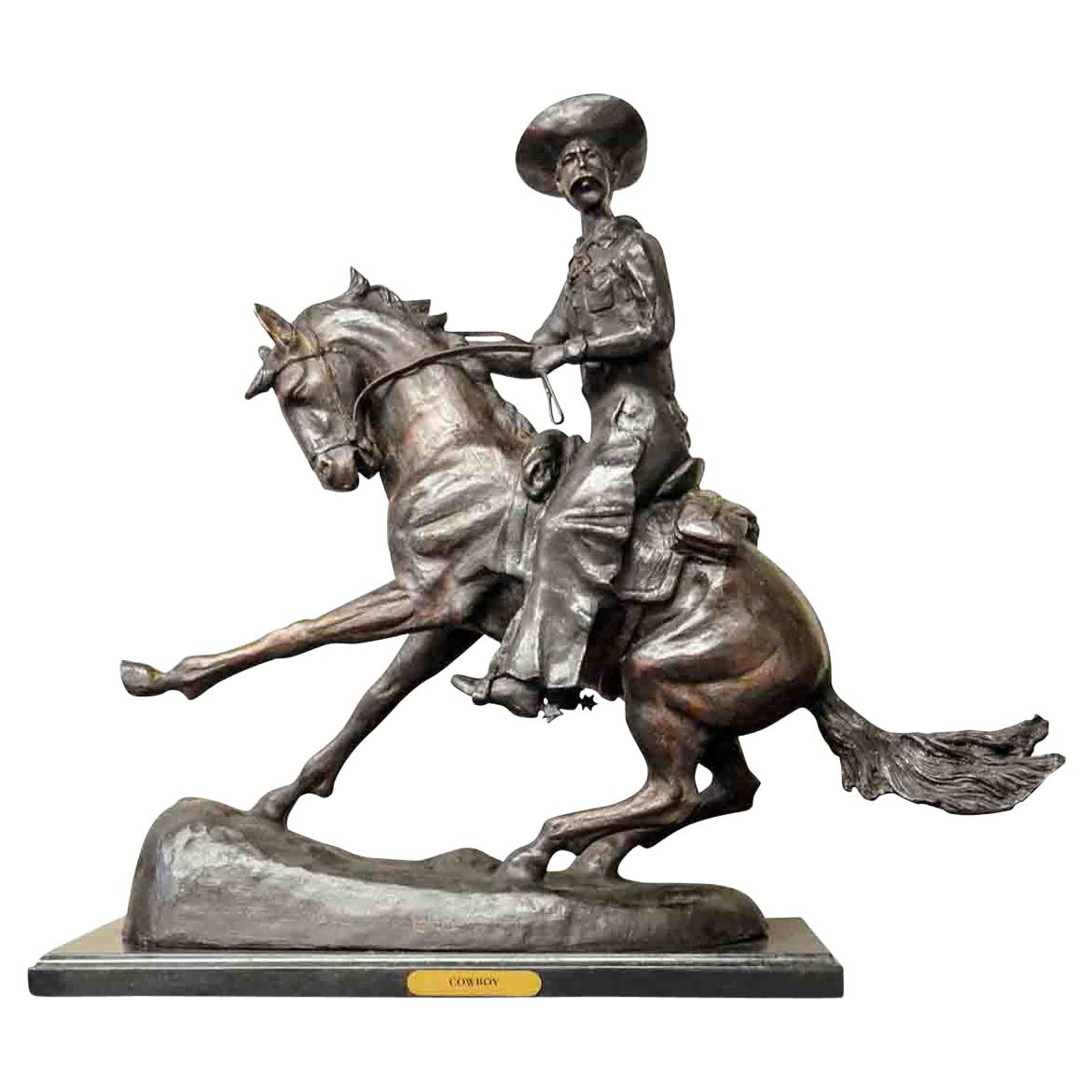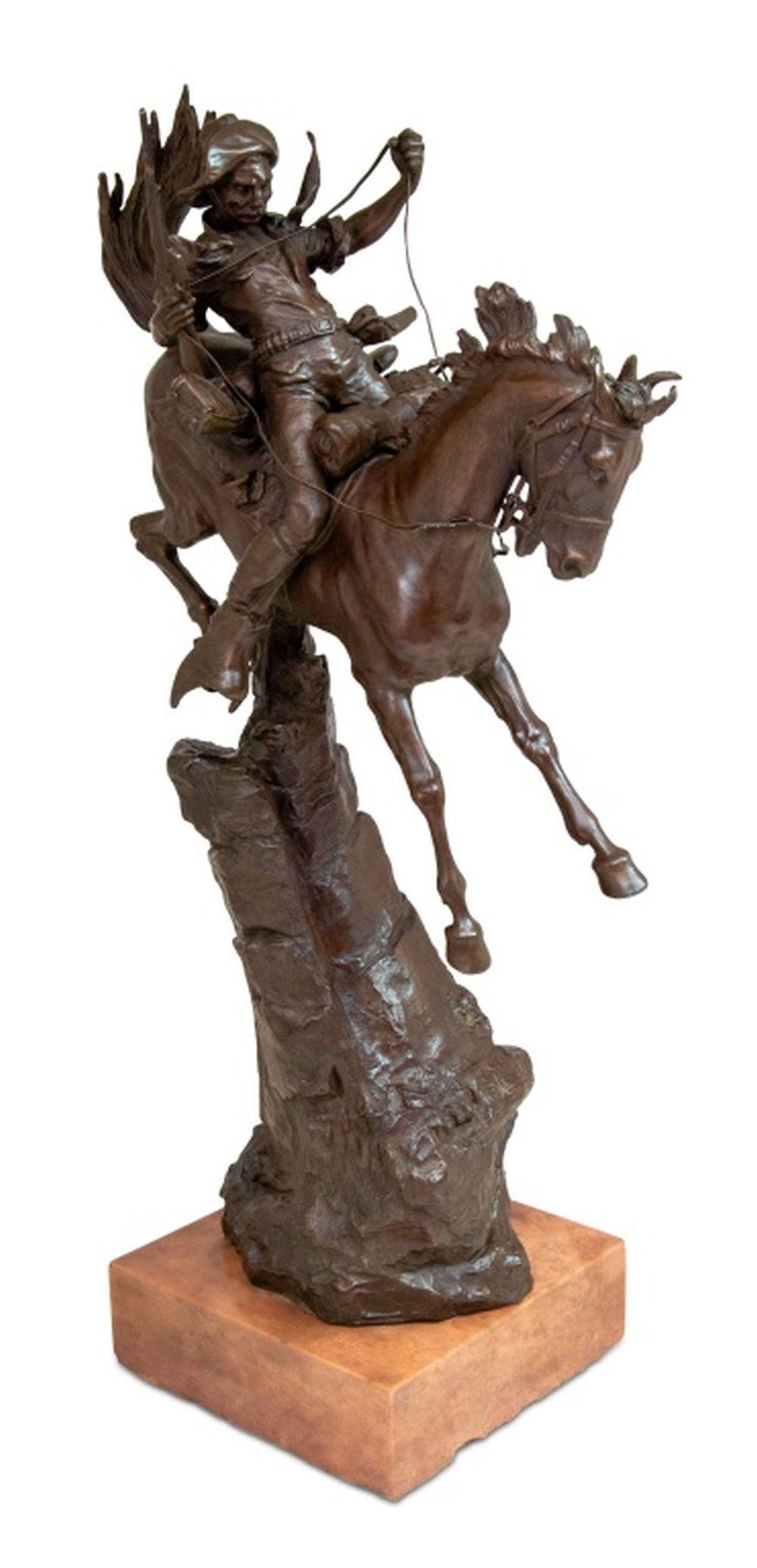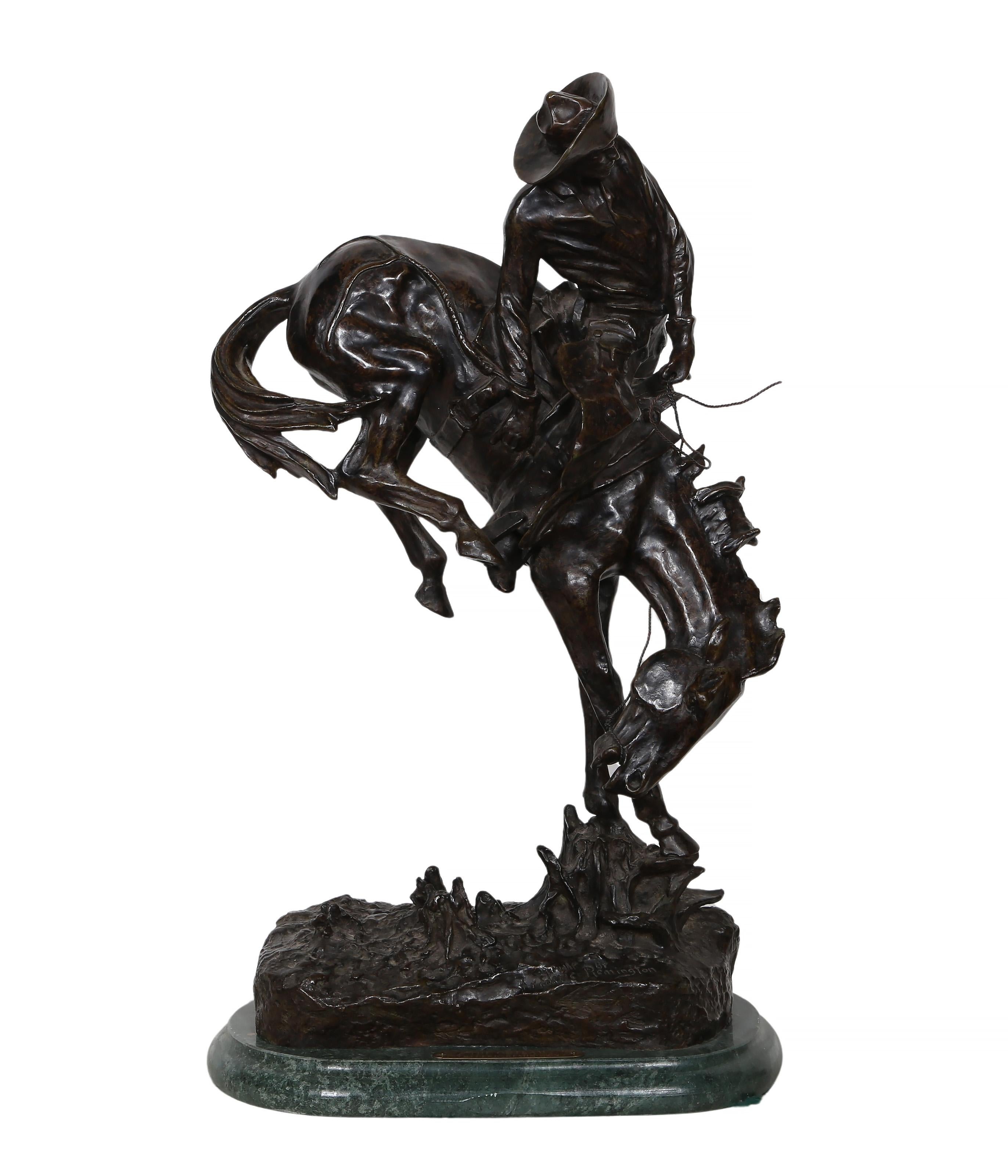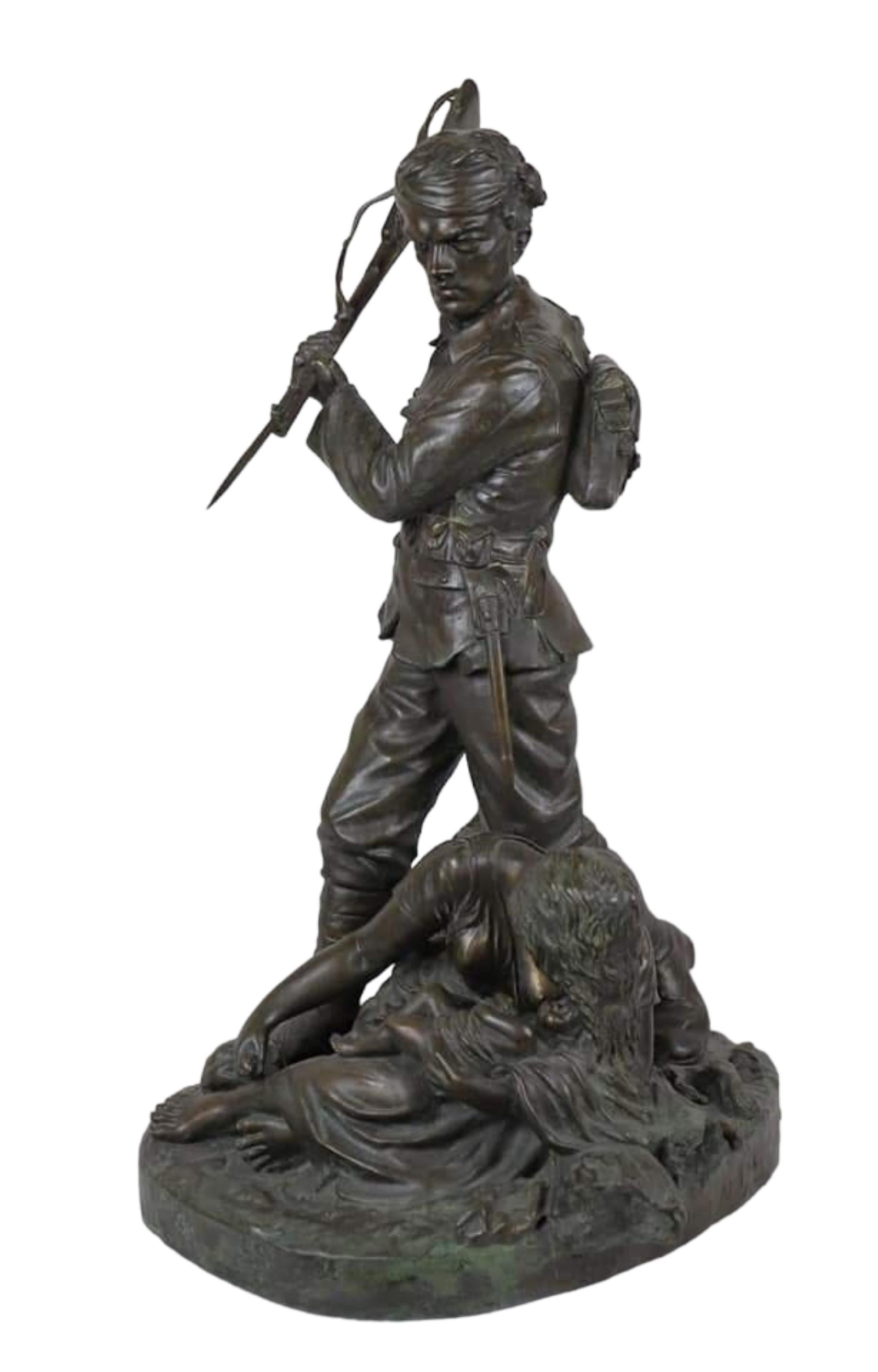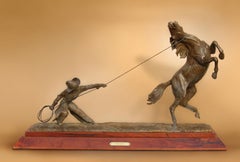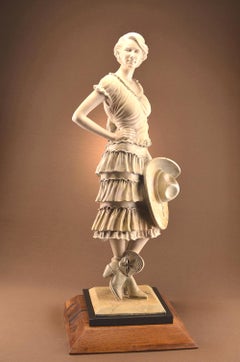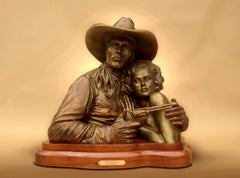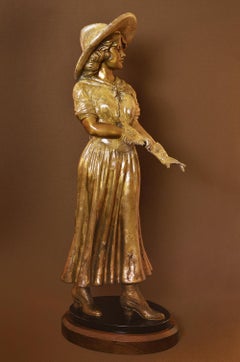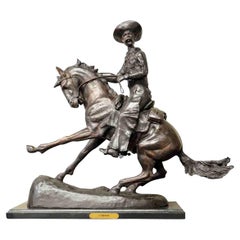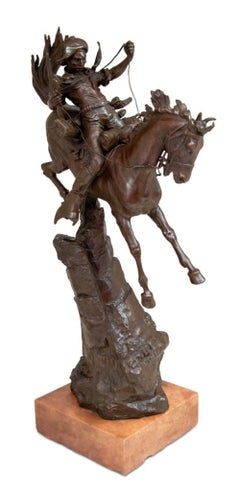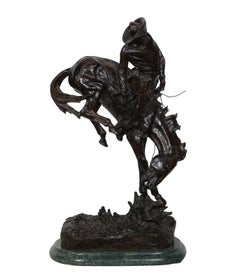Items Similar to " THE LAST DROP " Charles Schreyvogel (1861-1912) BRONZE SCULPTURE 1903 WESTERN
Want more images or videos?
Request additional images or videos from the seller
1 of 10
Charles Schreyvogel" THE LAST DROP " Charles Schreyvogel (1861-1912) BRONZE SCULPTURE 1903 WESTERN1903
1903
$112,000
£85,066.76
€98,280.22
CA$156,972.04
A$175,681.24
CHF 91,692.11
MX$2,142,405.55
NOK 1,173,534.17
SEK 1,110,900.38
DKK 733,452.22
Shipping
Retrieving quote...The 1stDibs Promise:
Authenticity Guarantee,
Money-Back Guarantee,
24-Hour Cancellation
About the Item
Charles Schreyvogel
(1861-1912)
New York / New Jersey Artist
Image Size: 12" x 18.50" x 5"
Medium: Bronze Sculpture
1903
"The Last Drop"
Charles Schreyvogel (1861-1912) New York / New Jersey Artist
One of the better-known painters of Western subject matter, Charles Schreyvogel was especially interested in military life in the days of the disappearing frontier. His western scenes were usually subjects with landscape as the backdrop, and his depictions of Indians were that of people with dignity and pride. "His favorite theme was warfare between intruding whites and Indians defending their ancestral homelands." (Baigell, 321)
He spent most of his life as an impoverished artist and then earned what seemed like overnight fame. "When Remington died in 1909, Schreyvogel wore the mantle of premier Western artist for the brief remainder of his life." (Zellman, 557)
Schreyvogel was born in New York City and grew up in a poor family of German immigrant shopkeepers on the Lower East Side and also spent much of his childhood in Hoboken, New Jersey. He found work in art-related trades including as a Meerschaum pipe carver, goldsmith, and lithographer.
He taught himself to draw, but he studied with H. August Schwabe at the Newark Art League. By 1880, he was teaching drawing and painting and used the roof of his apartment in Hoboken as his studio. In 1887, with the help of several patrons, especially Dr. William Redwood Fisher, he went to Munich, Germany for three years and studied with Carl Von Marr and Frank Kirchbach. Dr. Fisher encouraged the artist to take an interest in western subject matter.
Returning to the United States, he had bad health and was advised to go West to regain strength, but he didn't have the money for several years so he satisfied his aroused interest by sketching cowboys and Indians he saw in Buffalo Bill's Wild West Show.
In 1893, Schreyvogel first went West, visiting Arizona and the Ute Reservation in southwest Colorado. He quickly regained his health and excelled as a horseman. He also learned sign language to communicate with the Indians to persuade them to pose for him. But the resulting paintings didn't sell in the East, so he, having married Louise Walther, earned money with portrait painting of miniatures on ivory while continuing to do western painting.
In the 1890s and 1900s, he made additional trips West, including the Blackfeet Reservation in Montana. In 1901, his work, My Bunkie, won the first-place honor, the Thomas B. Clarke Prize, at the National Academy of Design, and a market for his western paintings and sculpture was set. My Bunkie was a rejected painting that even his local cafe owner had refused to hang, and despairing, he had left it at the Academy. He was so sure he would get no recognition that he had not even bothered to leave his address.
He worked from studios in Hoboken, New Jersey, and from a farm in West Kill, New York, and his Academy success was followed by winning a bronze medal in Paris and another at the Pan-American Exposition in Buffalo.
The money he earned from this recognition allowed him to do more traveling in the West where he gathered material for his studio painting, many of them military scenes. Most of his canvases were large, but he was such a meticulous painter that he only completed about seventy-five western paintings. He also did some watercolors, and many of his paintings were reproduced during his lifetime.
He died in Hoboken from blood poisoning from a chicken bone lodged in his gum. His studio and collection are on permanent display at the Cowboy Hall of Fame in Oklahoma City.
Sources:
Peter Hastings Falk, Editor, Who Was Who in American Art
Matthew Baigell, Dictionary of American Artists
Michael David Zellman, 300 Years of American Art
CHARLES SCHREYVOGEL (1861-1912)
Literature:
J.D. Horan, The Life and Art of Charles Schreyvogel, New York, 1969, page 55.
Charles Schreyvogel was born in New York City in 1861 the son of migrant Germans bound and determined to make America their new home following departure from a tumultuous Europe and, specifically, Germany. His father, Paul, and mother Teresa Erbe Schreyvogel were shopkeepers in New York's lower east side. Charles was the second of three sons born in the family and from his early years in the public schools he surprised his teachers with delightful sketches.
These were the predecessors to his fervent desire to become an artist, an avocation that his prosperous, merchant father found little favor with. He was not to denied and early exposure to August Schwabe, a dedicated fan of the arts and struggling artists, and later to Dr. William Redwood Fisher, led to study in Europe at the Munich Art Academy with Karl von Marr and Frank Kirchback.
Charles Schreyvogel eventually became one of the most popular artists ever to depict the American West in paint and bronze. His early life of struggle with poverty and health led to an ever-present desire to excel. His first national recognition came from a first prize in the 1900 National Academy Exhibition with his entry, My Bunkie. Numerous works were reproduced as lithographs, gravures and platinum prints. The Duel is one such work to have been reproduced.
His extensive forays to the west resulted in field sketches that were used in his Hoboken, New Jersey studio to depict some of the most popular renditions of American cavalry officers and their Indian adversaries. His highly publicized debate with the very popular, and jealous, artist, Frederic Remington, over the authenticity of the ingredients and the scene depicted in his painting, Custer's Demand resulted in an outpouring of support from relatives and friends of Custer: his widow, Elizabeth, President Theodore Roosevelt and Col. J. S. Crosby, himself depicted in the work. His place in history was firmly established by his expertise and talent.
His works are scarce and sought after. Fewer than one hundred paintings are known to have been recorded due to his limited output and short life span. His works are held sparingly by major museums and collections worldwide.
Charles Schreyvogel was born in New York City in 1861 and died in Hoboken, New Jersey in 1912. A poor boy on the east side of New York City, Schreyvogel sold newspapers and worked as an office boy while being educated in the public schools. When his parents moved to Hoboken, he carved Meerschaum and was apprenticed to a gold engraver, then became a die sinker, and finally, in 1877, a lithographer.
By 1880, he was a lithographic artist and teaching drawing. By 1887, he had patrons enabling him to study in Munich for three years, the pupil of Carl Marr and Frank Kirchbach. When he returned, he existed as a lithographic artist while unsuccessful with portraits, landscapes, and miniatures on ivory. After sketching the Buffalo Bill Show personnel in New York, he was able to spend 1893 in the West.
For five months, he sketched in Colorado at the Ute Reservation, then went to Arizona to sketch the cowboys. When he came back to Hoboken with a collection of gear, he continued as a lithographic artist while his paintings of Western Army life did not sell. One of these paintings was My Bunkie, which he could not dispose of either as a painting or for lithography in 1899. Offered to a restaurant on consignment, it was hung in a dark corner, so Schreyvogel took it back and entered it in the 1900 National Academy exhibition without leaving his address. When My Bunkie won the highest prize of $300.00, no one at the Academy had until then heard of Schreyvogel or knew where he lived.
Immediately successful, Schreyvogel went West again in 1900, sketching troopers and Indians in the Dakotas for the series of paintings on the Western Army. In 1903, Remington who was the most important Western illustrator called Schreyvogel's work "half-baked stuff", but the soldiers depicted spoke up for him. His output was limited to relatively few major works per year because of the number of his research trips and the size of the paintings, but reproductions were widely published. One set of these was in the form of "platinum prints," that is, large photographs.
When he died in 1912 from blood poisoning after a chicken bone stuck in his gum, he left relatively few Western oils. There were also left clay models that were later cast into bronze.
Charles Schreyvogel was Frederic Remington's chief rival during the early years of this century, when interest in artistic depiction of the West was very high. Unlike Remington, Schreyvogel never worked as an illustrator, seeking instead to establish his reputation as an academic artist.
He was born in New York City and in 1886 went to Germany to study at the Munich Academy. Returning to America, he set up a studio in Hoboken, New Jersey, which was then a rural town surrounded by fields and marshlands. Almost immediately he became friends with Nate Salisbury, Buffalo Bill Cody's energetic manager for the Wild West Show, and Schreyvogel spent many hours sketching the Indians and cowboys whom he saw there.
In 1893 Schreyvogel journeyed to the Ute reservation at Ignacio, in the southwestern corner of Colorado. There he observed the Apache, Navajo, Utes, and other tribes who came to receive their government allotments, and he listened to their stories of the Plains Indian wars. He collected great quantities of artifacts, including full costumes and uniforms, which he later utilized in paintings. Returning to Hoboken, Schreyvogel decorated his studio with memorabilia and photographs, and set to work methodically depicting the events of the Indian wars at the close of the frontier period.
The artist researched his subjects painstakingly through various methods of clay modeling and employing live models, prior to transferring their likenesses onto canvas. This enabled Schreyvogel's details to be carefully delineated and subordinated to the whole, which lent itself to telling the story in a complete and cohesive manner. "He is more than a historian of the Indian," one writer observed during the artist's lifetime. "He is giving us an invaluable record of those perilous days of the western frontier when a handful of brave men blazed the path for civilization and extended the boundaries of empire for a growing nation." These words were written after the death of Remington in 1909, when Schreyvogel was proclaimed "the greatest living interpreter of the Old West."
ReSources include: The American West: Legendary Artists of the Frontier, Dr. Rick Stewart, Hawthorne Publishing Company, 1986
Charles Schreyvogel worked as an apprentice to a gold engraver as a young boy and later became a die sinker. In 1877 he tried to earn income as a lithographer, but his lifestyle remained quite meager. He attended the Newark Art League and studied with August Schwabe and then went to the Royal Academy in Munich from 1887-90. He enjoyed painting Western scenes and was able to travel West due to the patronage of W.R. Fischer. While on his trip, Schreyvogel sketched in Colorado and Arizona. He made a second trip west in the same year to sketch troopers and Indians in the Dakotas for a series on the Western Army.
His work did not sell until he entered a painting from his travels, "My Bunkie", into the National Academy of Design exhibition in 1900. He won first prize and gained sudden success at the age of 40. "My Bunkie" is a dramatic Western scene of a cavalryman rescuing an unhorsed comrade from pursuing Indians. Schreyvogel was favorably compared with Frederic Remington, another Western genre painter. "Custer's Demand" (1903) received critical acclaim for its composition, drama and sense of color. Numerous works were reproduced and garnered a large following.
Schreyvogel died in 1912 of blood poisoning and left fewer that 100 known paintings.
- Creator:Charles Schreyvogel (1861 - 1912, American)
- Creation Year:1903
- Dimensions:Height: 12 in (30.48 cm)Width: 18.5 in (46.99 cm)Depth: 5 in (12.7 cm)
- Medium:
- Movement & Style:
- Period:
- Condition:Please view my other items. We have a large amount of Vintage Texas & American Paintings, Landscapes, Westerns, Mid Century. Also a large selection of Vintage Bohlin Parade Saddles.
- Gallery Location:San Antonio, TX
- Reference Number:1stDibs: LU769315482802
About the Seller
5.0
Vetted Professional Seller
Every seller passes strict standards for authenticity and reliability
Established in 1974
1stDibs seller since 2017
99 sales on 1stDibs
Typical response time: 1 hour
- ShippingRetrieving quote...Shipping from: Fredericksburg, TX
- Return Policy
Authenticity Guarantee
In the unlikely event there’s an issue with an item’s authenticity, contact us within 1 year for a full refund. DetailsMoney-Back Guarantee
If your item is not as described, is damaged in transit, or does not arrive, contact us within 7 days for a full refund. Details24-Hour Cancellation
You have a 24-hour grace period in which to reconsider your purchase, with no questions asked.Vetted Professional Sellers
Our world-class sellers must adhere to strict standards for service and quality, maintaining the integrity of our listings.Price-Match Guarantee
If you find that a seller listed the same item for a lower price elsewhere, we’ll match it.Trusted Global Delivery
Our best-in-class carrier network provides specialized shipping options worldwide, including custom delivery.More From This Seller
View All"HORSE TAMER" BRONZE SCULPTURE
Located in San Antonio, TX
John Bennett
(Born 1952)
Fredericksburg, Texas Artist
Image Size: 22 x 37 across x 10
Medium: Bronze
"Horse Tamer"
John Bennett (Born 1952)
John Bennett was designated Texas State Ar...
Category
20th Century Modern Figurative Sculptures
Materials
Bronze
"IF WISHES WERE HORSES" WESTERN BRONZE SCULPTURE
Located in San Antonio, TX
John Bennett
(Born 1952)
Fredericksburg, Texas Artist
Image Size: 27 tall x 12 x 8
Medium: Bronze Sculpture
"If Wishes Were Horses" Western
John Bennett (Born 1952)
John Bennett was ...
Category
20th Century Modern Figurative Sculptures
Materials
Bronze
"THE GUARDIAN" WESTERN BRONZE SCULPTURE
Located in San Antonio, TX
John Bennett
(Born 1952)
Fredericksburg, Texas Artist
Image Size: 19 x 15 x 19
Medium: Bronze Sculpture
"The Guardian" Western
John Bennett (Born 1952)
John Bennett was designated Te...
Category
20th Century Modern Figurative Sculptures
Materials
Bronze
"WILLOW" BRONZE SCULPTURE
Located in San Antonio, TX
John Bennett
(Born 1952)
Fredericksburg, Texas Artist
Image Size: 36 tall x 13 x 14
Medium: Bronze
"Willow"
John Bennett (Born 1952)
John Bennett was designated Texas State Artist 20...
Category
20th Century Modern Figurative Sculptures
Materials
Bronze
"BELLE STARR" BRONZE SCULPTURE
Located in San Antonio, TX
John Bennett
(Born 1952)
Fredericksburg, Texas Artist
Image Size: 25 x 18 x 4
Medium: Bronze
"Belle Starr"
John Bennett (Born 1952)
John Bennett was designated Texas State Artist 201...
Category
20th Century Modern Figurative Sculptures
Materials
Bronze
"WORKING AS ONE" COWBOY WESTERN BRONZE ORIGINAL STUDIO COPY
By G. Harvey
Located in San Antonio, TX
G. Harvey (Gerald Harvey Jones)
(1933-2017)
San Antonio, Austin, and Fredericksburg Artist
Image Size: 16 x 15 tall
Medium: Bronze Sculpture / Studio Copy
1984
"Working as One"
G. Harvey, known for paintings closely linked in mood and subject matter to Edouard Cortes [1882-1962], G Harvey creates romanticized street scenes of turn of the century towns in America. Rain slick streets reflect urban lights, and the weather is obviously cold. He grew up in the rugged hills north of San Antonio, Texas from where herds of longhorn cattle were once driven up dusty trails to the Kansas railheads. His grandfather was a trail boss at 18 and helped create an American legend for his grandson. So, the American West is not only the artist's inspiration but his birthright. Harvey's early interest in sketching and drawing slowly evolved into a passion for painting in oils. After graduating cum laude from North Texas State University, Harvey took a position with the University of Texas in Austin, but he soon realized that weekends and nights at the easel did not satisfy his love of painting. He abandoned the security of a full-time job in 1963 and threw his total energy into a fine art career. Harvey paints the spirit of America from its western hills and prairies to the commerce of its great cities. His original paintings and bronze sculptures are in the collections of major corporations, prestigious museums, the United States government, American presidents, governors, foreign leader and captains of industry. The Smithsonian Institution chose Harvey to paint The Smithsonian Dream, commemorating its 150th Anniversary. The Christmas Pageant of Peace commissioned Harvey to create a painting celebrating this national event. He has been the recipient of innumerable awards and the subject of three books. Today, G. Harvey lives in Fredericksburg, Texas, with his wife Pat in a 150-year-old stone home built by German settlers. His studio and residence are nestled within the Historic District of Fredericksburg. It is obligation of fine artists to present us with more than pretty pictures. They must also make us feel. Among the western painters of today, there is none more capable of accomplishing this than G. Harvey. In his paintings, the viewer into only sees the physical elements of his subject, but also senses the mood that surrounds them. It is a remarkable aspect of fine art, which few artists are able to master. Gerald Harvey Jones was born in San Antonio, Texas, in 1933. His grandfather was a cowboy during the trail-driving era when legends grew up along the dusty trails north from Texas. Family stories of wild cattle and tough men were absorbed by a wide-eyed boy and became the genesis of G. Harvey's art. A graduate in fine arts at North Texas State University, Harvey taught full-time and painted nights and weekends for several years. It was through painting that he found his greatest satisfaction, and his native central Texas hill country provided the inspiration for most of his earliest work. With the development of his talent and the growth of his following, Harvey began to expand his artistic horizons. He left teaching and concentrated on a career in fine art. He sought the essence that is Texas and found it not only along the banks of the Guadalupe, but in cow camps west of the Pecos, and in the shadows of tall buildings in big Texas cities. The streets of Dallas once echoed with the sound of horse's hooves and the jingle of spurs. Historic photographs reveal what it looked like, but only an artist like Harvey can enable a viewer to experience the mood and flavor or the time. Contemporary west art has too often centered on the literal representations from its roots in illustrations. Artists like G. Harvey take us a step further, to the subjective impressions that are unique to each great talent, and which constitutes something special and basic to fine art expression. Harvey is a soft-spoken and unassuming man who cares deeply about what he paints without becoming maudlin or melodramatic. We sense there is more in each Harvey painting than just that which is confined to the canvas. Resources include: The American West: Legendary Artists of the Frontier, Dr. Rick Stewart, Hawthorne Publishing Company, 1986 Artist G. Harvey grew up in the rugged hills north of San Antonio, Texas from where herds of longhorn cattle were once driven up dusty trails to the Kansas railheads. His grandfather was a trail boss at 18 and helped create an American legend. So, the American West is not only the artist's inspiration but his birthright. Harvey's early interest in sketching and drawing slowly evolved into a passion for painting in oils. After graduation cum laude from North Texas State University, Harvey took a position with the University of Texas in Austin, but he soon realized that weekends and nights at the easel did not satisfy his love of painting. He abandoned the security of a full-time job in 1963 and threw his total energy into a fine art career. Two years as a struggling artist followed, but 1965 brought acclaim for the artist's first prestigious show, The Grand National exhibition in New York, and the American Artists' Professional League presented him with their New Master's Award. President Lyndon Johnson discovered his fellow Texan's talent, became a Harvey collector and introduced John Connally to the artist's work. Connally was enthusiastic about Harvey's art, and, on one occasion, he presented a G. Harvey original to each governor of Mexico's four northern states. Harvey paints the spirit of America from its western hills and prairies to the commerce of its great cities. His original paintings and bronze sculptures are in the collections of major corporations, prestigious museums, the United States government, American presidents, governors, foreign leader and captains of industry. The Smithsonian Institution chose Harvey to paint The Smithsonian Dream commemorating its 150th Anniversary. The Christmas Pageant of Peace commissioned Harvey to create a painting celebrating this national event. He has been the recipient of innumerable awards and the subject of three books. Through his art, our history lives. Today, G. Harvey lives in Fredericksburg, Texas, with his wife Pat in a 150-year-old stone home built by German settlers. His studio and residence are nestled within the Historic District of Fredericksburg. Gerald Harvey Jones, better known as G. Harvey, grew up in the Texas Hill Country listening to his father and grandfather tell stories about ranch life, frontier days in Texas, and driving cattle across the Red River. Early in his career, he began to draw inspiration from that collective memory for paintings that would eventually earn him the reputation as one of America's most recognized and successful artists. His art is rooted in the scenic beauty of the land he grew up in and the staunch independence of the people who live there. He says, "My paintings have never been literal representations. They are part first-hand experience, and part dreams generated by those early stories I heard. They are a product of every place I have been, everything I have ever seen and heard." G. Harvey graduated from North Texas State University. He taught in Austin, but continued to study art in his spare time, eventually devoting full time to his painting. The year 1965 was a turning point when he won the prestigious New Masters Award in the American Artist Professional League Grand National Exhibition in New York. It is often said that in viewing a work of art, one is granted a unique look into the thoughts and expressions of values that give meaning to the artist work. Nowhere does this ring truer than the art of G. Harvey. Though Harvey has had nearly two decades of sell-out shows, an outstanding honor came with a series of one-man shows in Washington, D.C. in 1991. The first was at the National Archives featuring his paintings of the Civil War era, then a selection of paintings of notable Washington landmarks was exhibited at the Treasury Department, culminating in a one-man show of 35 paintings at the Smithsonian Institution during their exhibition of The All-American Horse. His work was featured in Gilcrease Museum exhibitions from 1992-1997. In 1987 his alma matter honored him with a Distinguished Alumni Award. One of Harvey's paintings was featured on the cover of Smithsonian Institution's 150th anniversary engagement book. He now has four books published and resides with his family in The Texas Hill Country. integrity, strength, courage, faith, heritage - these are compelling words that have often been used by collectors and art critics alike to describe that intrinsic value that courses through every original painting or sculpture by artist G. Harvey. Whether drawing inspiration from his own deeply rooted Texas heritage or his world travels with wife Patty, the human experience is fully revealed in his art. He is often credited with technical brilliance as his goal is to approach each subject with discipline, maturity and artistic integrity. Yet beyond this vast and well-schooled knowledge, is a deeper set of values, an inner luminosity that transcends time and place, evoking familiar sights, sounds, moods and emotions. Harvey grew up in San Antonio, Texas. He resides now in Fredericksburg, Texas where he lives in a 150-year-old stone home built by German settlers. Lyndon Johnson introduced his works to John Connally who presented a G Harvey original to the governors of four Northern Mexican states. He celebrated a one-man show at the Smithsonian Institution entitled The All-American Horse. Harvey has always believed that history lives through art including the epic struggle between the states, the western migration, the brief time when horses and automobiles clattered across cobblestones together. He is faithfully able to capture the drama and feeling of such a moment in time.
Please view my 1stdibs store front for other Great Vintage Texas...
Category
1980s Impressionist Landscape Paintings
Materials
Bronze
You May Also Like
Cowboy, Cast Bronze Sculpture on Marble Base, after Frederic Remington
By (after) Frederic Remington
Located in Yonkers, NY
Cowboy, a cast bronze sculpture after American artist Frederic Remington's original, on marble base. Filled with a great dramatic tension, this bronze sculpture depicts a scene from the American Old West...
Category
20th Century Animal Sculptures
Materials
Marble, Bronze
Carl Kauba "Desperado" Patinated Bronze Sculpture
By Carl Kauba
Located in Astoria, NY
Carl Kauba (Austrian, 1865-1922) "Desperado" Patinated Bronze Sculpture, 20th century, the U.S. Cavalryman and his horse mounted on a rocky outcrop, signed, and stamped "Austria", on...
Category
Early 20th Century Naturalistic Figurative Sculptures
Materials
Bronze
The Outlaw, American Realist Bronze Sculpture after Frederic Remington
By Frederic Remington
Located in Long Island City, NY
Frederic Remington, After, American (1861 - 1909) - The Outlaw, Medium: Bronze Sculpture on marble base, signature inscribed on the base, Size: 25 x 14 x 7 in. (63.5 x 35.56 x 17.7...
Category
Late 19th Century American Realist Abstract Sculptures
Materials
Bronze
Charles Cary Rumsey (American, 1879-1922) Colt Scratching Bronze Sculpture
By Charles Cary Rumsey
Located in Bristol, CT
CHARLES CARY RUMSEY (American, 1879-1922)
Colt Scratching Nose, 1917
Roman Bronze Works casting
8"H x 10 1/2"L x 4 3/8"D
Weight: 9.12lbs
Inscribed on the base: CC Rumsey
LITER...
Category
1910s Sculptures
Materials
Bronze
Charles Cary Rumsey (American, 1879-1922) Colt Scratching Bronze Sculpture
By Charles Cary Rumsey
Located in Bristol, CT
CHARLES CARY RUMSEY (American, 1879-1922)
Colt Scratching Nose, 1916
Roman Bronze Works casting #15/ 40
6 1/4"H x 7 1/2"L x 2 1/2"D
Weight: 5.8lbs
Inscribed on the base: CC Rum...
Category
1910s Sculptures
Materials
Bronze
Casualties of War, 1918 Bronze by Richard Claude Belt, English Sculpture
Located in Grand Rapids, MI
Richard Claude Belt (English, 1851-1921)
Signed: R. Belt 1918 (base verso)
" Casualties of War " 1918
Bronze
Height 26"
Width 15"
Depth 13"
In very good original condition w...
Category
Early 20th Century Figurative Sculptures
Materials
Bronze
More Ways To Browse
Antique European Sculpture
Antique Bronze Sculpture Signed Art Sculptures
Antique Bronze Sculpture Artists
Money Sculpture
Charles Page
Royal Art Lodge
Antique Western Signs
90s Bronze
Bronze Pan
Reproduction Bronze Sculpture
Miniatures On Ivory
Antique Colorado
Antique Gold Pan
1900s Bronze Sculpture
Mantle Sculpture
1880s Bronze Sculptures
Bronze Soldier
Antique Baking
